As the Covid-19 outbreak takes hold in the country our Government has directed amongst other things that we eliminate all un-necessary travel and can only go outside for exercise and to do some shopping. These two restrictions somewhat limit my photographic options this month which after a promising start elsewhere as of now has been somewhat limited and the closing of various parts of Richmond Park limit them even more but not all is lost. Whilst I would like to be out visiting the coast and some of my favourite bird photography places such as Blue House Farm in Essex and Rye Meads in Herts, which are in effect my local wildlife patches, such options are no longer possible at present and so I need to look closer to home. Now I am lucky to have Richmond Park nearby, two bus stops up Kingston Hill there is Ladderstile Gate (not that I use the bus but walk instead) and then Kingston Gate is a similar distance but down the hill followed by a right turn down Queens Road, just over a ten minute walk if that.
My local patch has therefore become the area between these two gates and extending the mile or so out to Ham Gate and up to Isabella plantation. Now the cyclists and motorists have been banned from the Park it is quiet and enjoyable and the number of people on the paths is not too great and all those walking are either alone or in household groups. A few idiots still go to the Park and ride their bikes despite the notices saying not to and in the flat, grassy areas a few people sit and sunbathe, both being against the spirit of the current Government guidelines so hopefully the Police and Park authorities will continue to keep it open in spite of those idiots who appear to want to get the place closed to everyone.
Now the advantage of having a local patch is you can visit every day and wander around noticing more and more if you are lucky and observant enough to see what is there. The first thing to say is at this time of year the trees are just coming into leaf and flower so they are in the main bare of any foliage making it possible to get good views of any birds flitting around them. To be sure the most obvious are the numerous Ring-necked Parakeets, both due to their constant noise and their bright green plumage which shines when the sunlight hits the birds as they fly through the woodland before perching on a bare tree trunk or branch. A couple of times a male is seen feeding a female but only one mating pair is seen by me. The other common birds are the Crows and the Jackdaws which like the Parakeets investigate holes in the trees for potential nesting sites but most of the time they are seen foraging on the ground and on occasion with beaks full of small twigs, nesting material.
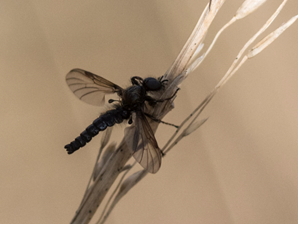
A few Oak trees glow yellow green especially when back-lit as their flowers and leaves start to burst out of buds and the finger like leaves of the Horse-Chestnut pop out of the sticky sheaves of their buds adding to the greenery but in the main the other trees lag behind and remain free of colour. Smaller birds are attracted to the opening flowers and leaves and no doubt insects are also around on which some of the birds feed although only the yellow of a male Brimstone and the dark flight of Peacock butterflies are visible on the sunnier days. A Peacock, so beautiful on the upper side compared to the almost black under is defending sunny patches of mud from its rivals while the sulphur yellow, male Brimstones are more intent on flying around no doubt searching for the elusive females of which only one is spotted. March Flies (Bibio sp similar to, but which are not St. Mark’s Fly) are seen on the round rush stems by the edge of a small muddy pond on far side of Isabella Plantation.
A few days later having found what I think is a mining bee lek at the end of a fallen tree trunk, some Andrena species do this with the males hatching first and then waiting around to mob the freshly hatched females I take some photos in the poor light to try to get an identification of these bees after getting home. Well there was no need to wait that long because the bees identified themselves as honey bees when one of them stings me… The pretty large, half egg sized, swelling only takes three days to go down although on the first night there is no sign of what was to come. Still a lesson learned and just because it now possible to see through the right eye with the glasses on, since the cataract operation last year, that only works well for distance and not for close up things at least when wearing the glasses…
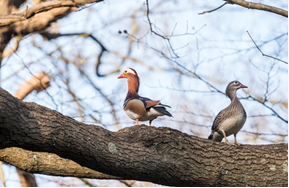
Isabella Plantation has been coming into bloom with lots of daffodils and the trees, heather, Wood Anemones, Arums and more exotic plants also coming into flower and then it is closed due to people gathering there, a shame from the natural history point of view because it can be good for both plants and wildlife. Unfortunately due to the restrictions the mass of Bluebells that will flower there later in the month will be missed however I do get to enjoy the Plantation on some days before the closure and in particular looking at the ponds where the Mandarin ducks are pairing up and with both the flamboyant male and more classy and elegant looking females both showing well. One highlight is looking up to see a pair of these ducks perched on a tree branch and pointing it out to a passing stranger who is suitably surprised and impressed. I knew Mandarin ducks nested in trees but this is the first time I have seen them perched on a branch. Peg Pond within the Plantation is visible from outside the fence but only Coots, Mallard, the occasional Canadian Goose and Tufted Duck are noted swimming on it. A Grey Heron perches there in the trees once in a while but one, maybe the same bird, is more regularly seen on the edge of the pond near Ham Gate.
Many of the smaller birds like Dunnock, Robin, Great Tit and Blue Tit are readily spotted on my daily walks along with one of my favourite birds, Long-tailed Tits. These are showing as pairs rather than being in the large winter flocks so I am seeing one or two of them at a time rather than a dozen or more. Robins sing from tree branches and then fly to the ground to pick up whatever they are after, presumably insects, before returning to their perch and continuing their song which is often very loud and melodic.
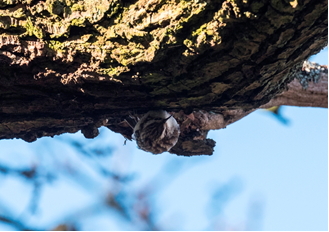
There are a couple of birds I have always wanted to come across in the Park and now having spent so much time there I am seeing them. A Treecreeper is spotted on a dead tree. It looks like a mouse moving along the branch, the diagnostic white belly is seen and the photographs confirm its identification. I am happy to find one because I rarely see them in the UK and it is the first time I have taken any decent, although not really good, photos of this bird.
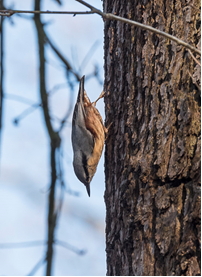
Although happy with the Treecreeper seeing another bird makes me even happier and now I recognise the call I have seen it in several places around my patch. At least two male Nuthatches call close to Ladderstile Gate but the best sighting is of two pairs on the path leading down the hill to Kingston Gate. There is a small bird feeding on a small tree and I struggle to work out what it is. My camera with the long lens comes out of my rucksack and as I wait the birds fly around before coming into the trees near to me. There are four of them and then one of the birds flies at another, there is a bit of commotion and two of the birds eventually fly off leaving the other two to continue feeding. Now this is the first time I have seen Nuthatches in the UK for many, many years and my first photographs of them although I did get shots of Kruper’s Nuthatch (a different species) in Turkey last year. It is a fantastic ten to twenty minutes just standing there watching and photographing these birds as they go about there business. Of course on the same tree and investigating a hole there is also a pair of the ubiquitous Parakeets…
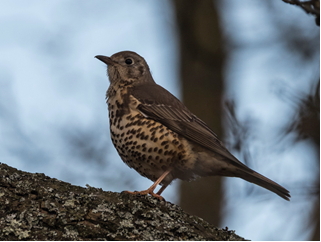
Flying in and about the brown, old growth Bracken, Wrens sulk, call and flutter around, their distinctive golden brown colour and their small size and shape making them instantly recognisable. Occasionally a Blackbird is also disturbed from the Bracken but most of the time they are shy and wary of people flying off as soon as you get close to them. A pair of large thrushes are seen amongst the grass near to Ladderstile Gate, possibly Fieldfares, they are only seen the once and in Isabella Plantation, before it is closed to the public, a Song Thrush is seen turning leaves in a small damp, dark glade.
Perhaps the most iconic bird of the Park, other than the Jackdaws and Parakeets, is the Green Woodpecker but they still continue to elude my camera lens. A few fly up into trees but they are shier birds than the Blackbirds and disappear when they notice a human. However their calls echo around the Park at times and without the traffic and aircraft noise they are much easier to hear now. Almost as shy are the Greater Spotted Woodpeckers and although their continuous loud hammering has not been heard whilst walking around the Park a pair are seen flying from tree to tree, never allowing a close approach but looking fantastic in the bright sunshine. Their distinctive hammering is still heard in short bursts when they are hunting prey rather than calling out for a mate which goes on for much, much longer!
Birds of prey are not often found by me in the Park although there are owls, Little Owls are often seen around Petersham Lodge (off my patch!), Sparrowhawk which I have seen once perched in a tree but that was last year, Kestrels, the very occasional Red Kite and this month a pair of Buzzards put in an appearance. One day they soar around Ladderstile Gate for five minutes or so before disappearing and the next day there is a pleasant surprise when looking out of my flat window (more on that later) as a beautifully marked Buzzard is being mobbed by several Crows It is a magnificent looking bird and if only the light is better and my camera with long lens is close to hand. A missed photographic opportunity for sure but it is still a delight to see such a fine looking bird from my flat window.
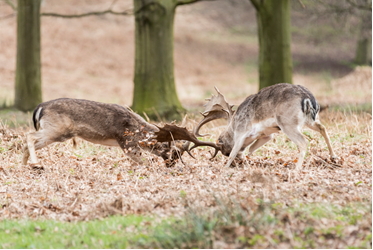
And onto the deer which is really why there is a Royal Park here in the first place. Not many Red Deer have been seen although a small group can often be found near to Isabella Plantation. However Fallow Deer are more visible than normal and a small group of males, one with a full set of antlers and the others being younger and with no real antlers, are seen hanging around the slopes close to Ham Gate. However this group must have crossed the road one day because I follow a small group and then hear a loud crashing sound, the clashing of antlers as it turns out. There is a herd of about six to ten females with a male who is determined to see off any threat to his rule. The two males both with well developed antlers keep clashing and going at each other for about ten minutes, or maybe it is a bit longer and then the whole herd seems to be running towards me with the victor chasing off the vanquished. Even once the loser has become separated from his other young, male companions that are in attendance he keeps tasting the air so no doubt the females are coming into heat and he wants his chance to mate. Most of the rutting goes on late in the year so I consider myself lucky to have witnessed the event in March. After that I go home as there is not much else to see on that basically grey, overcast day.
To give some indication of where I live my flat is on the third floor from the front of the block and being built into a hill is four floors up from the back which overlooks west London, with a view to the rather quiet Heathrow Airport situated seven, or so, miles away. There are some tall trees in the garden and surrounding gardens with a stables (at least for the time being) located to the right as you look out of the living room window. So apart from the aforementioned Buzzard that was seen from my window a few other sightings include some Parakeets feeding on the trees, Magpies with their blue and green iridescence showing well floating around the garden chasing other birds and perching on top of the fir tree and then there are Jays, a pair first noted on the Silver Birch tree at the entrance to the flats and then also flying around the garden with the Magpies chasing after them once in a while. The advantage of being up high is that you look down and the Jays when views from above and being lit by the sunshine look fantastic with the blue on the wings shining and the white flash and black edged tail standing out as they glide from branch to branch, a view I of them I have never seen before and what a shame my lens is not long enough to capture them at this distance.
Grey Squirrels inhabit both the Park and our garden. They seem conspicuous in the garden but are less easy to find in the Park. They are there and seen on a regular basis but in nowhere near the numbers I would expect. They are not the only mammals around, badgers are resident in the Park, a neighbour has even seen them wandering around the garden although I have not and there are Red Foxes. Often they are heard, especially the screaming vixens when they are calling for a mate but on Thursday 2nd April (so technically outside of March) one is seen wandering through the small garden, it does not hang about but keeps moving. Now that may be because it is round about 20:00hrs and the clapping for the frontline health care staff has started so it is noisy with not just clapping and cheering but car horns beeping and even some fireworks going off. The fox is probably a little scared by all the noise hence the reason it just keeps moving. Best of all from my flat window is to see bats flying around about dusk, normally I would be in the pub at this time so would not see them. This is my first views of bats for many years and it is good to see them again.
So there we have it, my natural history highlights from March, not the month of doing what I would have wanted and not being in the places I would have wanted to be but even so having a local patch means you can get out and about and still find and observe things others often miss or which you just do not normally see. And so it has proven.
 Leave a comment about this comment
Leave a comment about this comment